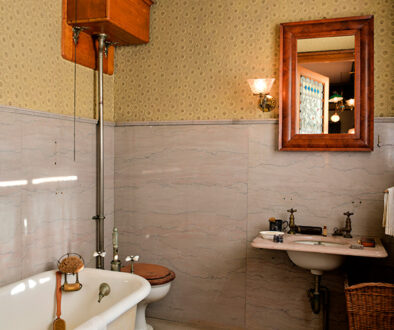Design to Make You Happy
Here’s some regrettable news: according to fashion sources like Vogue and InStyle, skinny jeans are making a comeback. If that news has you bracing yourself for the inevitable and recurring shimmy that’s required when wearing skin-skimming jeans, we have better news for you: you don’t have to follow this or any other trend, unless said trend actually induces joy.
In fact, trends come and go so quickly—especially when it comes to fashion and home design—that blindly following them doesn’t always make sense. And while there’s very little risk in following an unfortunate fashion trend—we’ve all been guilty of trying things like parachute pants, velour tracksuits, or shirts with cutout shoulders—when it comes to interior design, following trends can be especially costly. Which is why designing to make yourself happy, regardless of a trend, is so important.
For Jennifer O’Connor of O’Connor Home Design—which just opened a showroom on Texas Avenue in Cape May—above all else, a home should feel like you.

“Just like your clothes are an outward expression of yourself, your home is that too,” says O’Connor. “When someone walks into your space, it should feel ‘you.’ Trends will come, go, and most likely come back again. I don’t discourage my clients from following trends, but I encourage them to make choices based on what feels good. You know when you’re naturally drawn to something—it’s like saying yes to the dress.”
While O’Connor acknowledges that the rise in social media apps like Pinterest and Houzz as well as home makeover shows have contributed to some unrealistic expectations for people, she’s noticed a trend herself: a shift in client preferences towards more personalized and happiness-driven design.
“I think we can all say the pandemic greatly impacted the way we feel about our homes and forever changed the way we think about their design. Functionality, multi-purpose spaces, comfortability and practicality are most important,” says O’Connor. “People are spending more time in their homes.”
So, how do you design for your own joy?
“I always start with an inspiration piece, whether I provide it, or the client does,” says O’Connor, whose inspiration for the O’Connor Home Design Showroom was a bold floral print pillow with lots of color. “I planned the whole showroom around it.”
O’Connor’s goal when creating the showroom was to have guests immediately feel a vibe, to showcase her own design style while offering clients and customers the opportunity to choose furniture, materials, and color combinations that speak to them. And while many of her customers utilize O’Connor’s services to design homes rather than workspaces, the principals are the same.

“Interior design has the power to create a mood—certain colors, patterns, and lighting can evoke emotion,” she says. “When you walk into a room, you want it to make you feel a certain way. Whether you’re looking for relaxation in your bathroom or serenity when retiring to your bedroom at night, a room should make you smile and should be a reflection of you. Interior design is individualized—my goal as a designer is to guide all my clients in discovering what makes them smile.”
Though everyone’s project is unique, and each client has their own preference, O’Connor does see some style elements that evoke happiness: warmth, color, and function. And unless you’d be comfortable living in a sterile or museum-like environment, consider how user-friendly your design concept is before the start of a project.
I believe in designing for durability and functionality,” says O’Connor. “By taking the time to research performance fabrics, finding quality pieces, and taking into consideration the practicality of items, we can design homes that you can live in. I think taking away the stress of worrying about items as if they belonged in a museum is joyful and uplifting.”
The importance of personality
When considering the happiness of your home, explore the usual culprits—lighting, color, patterns—but don’t forget to dig deeper. In fact, the inclusion of personal mementos and artifacts that reflect our personalities can be particularly meaningful.
“Look for inspiration in your everyday life and [incorporate] that into your space with whatever makes your heart sing,” says O’Connor. “Think of your hobbies, family, and friends, traveling experiences, or a beautiful scene in nature. There’s inspiration in everything from color schemes to textures.”
The key is balance. Style is immensely important, but functionality, and having the space to meet your needs, is just as critical. In addition to personal items, there are certain practical colors, textures, and materials that are particularly effective in promoting a happy atmosphere.
“If you were to look at my designs, you would find a common theme in the shades of blue and green I use,” says O’Connor. “These colors remind me of the ocean, the calmness and serenity I feel at the beach and living in our peaceful town of Cape May. Blue goes with everything, just like denim. It will never go out of style.”
And of course, it helps to work with a designer that can help you see your vision, and to be able to make your dream a reality. “If a client is struggling with a decision or I foresee an issue, I always suggest other alternatives and provide a visual component that will help display an end result,” says O’Connor. “Mood boards and 3D perspectives are crucial. My job is not complete until I know a client is truly happy with the result of their space.”

Trends have the power to inspire, and that can be a great thing. But designing for yourself and the joy of your family takes precedence every time.
“Honestly, trends are created to keep consumers buying new products,” says O’Connor. “I get it and most of the time I like the trends, but sometimes I do not. I see them as guidelines. Most people like to be of the times and to ‘keep up,’ but if you design a space true to yourself, you will always love it. A house is never complete—that’s where accessories help to keep things fresh. New drapes or lamps can make a huge difference.”
“Pinterest and social media drive people to follow trends,” she continues. “I have a feeling that the next generation will focus on being true to themselves more.”



